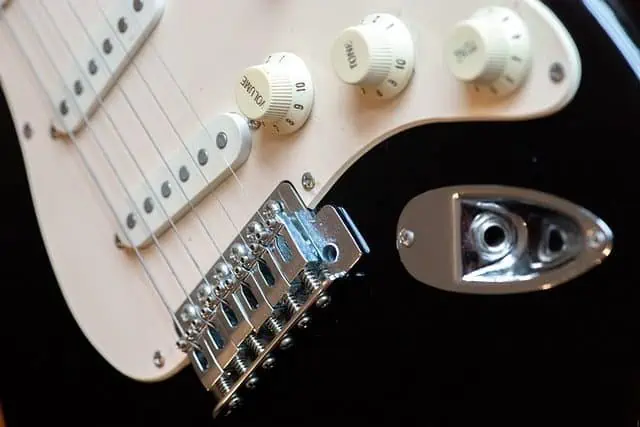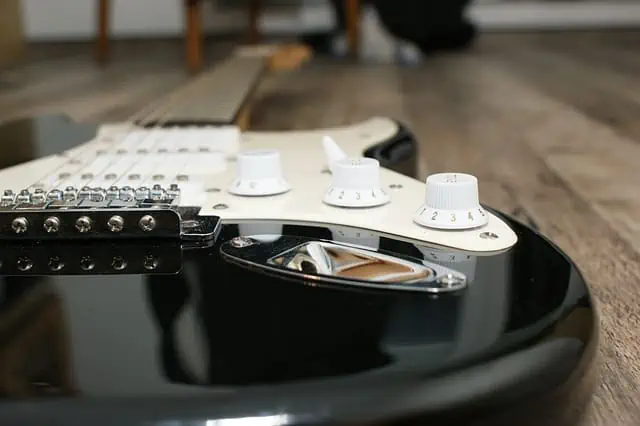If you’re on a budget, the Squier Affinity Stratocaster may have caught your eye. It’s definitely true that in many cases, if you wanted a Fender but needed a more budget-friendly guitar, Squier is the way to go. After all, Fender acquired them in the 60s.
So let’s check out the Squier Affinity Stratocaster series and see if they’re right for you.
Contents
Squier vs Fender
I thought a bit of an overview of the two guitar brands is in order. As I said, Squier is the budget-line by Fender. While Squier guitars look roughly the same as their Fender counterparts, they are generally constructed from cheaper materials. They’re also made in countries where labor is cheaper. For this reason, they’re pretty good as beginner guitars. However, if they’ve been set up properly, they can take you well into your gigging days too.
An Overview of the Squier Affinity Stratocaster Series
These guitars come in three different configurations:
Affinity Series Stratocaster SSS
You get:
- 3 x single coil ceramic pickups
- 5-way pickup selector
- 1 x master volume knob
- 1 x neck and middle pickup tone knob
- 1 x bridge pickup tone knob
- 2-point tremolo bridge
- Adjustable block saddles
- Sealed die-cast tuning machines with split shafts
This guitar is available in the following colors according to the Fender site:
- 3-color sunburst
- Olympic white
- Black
- Lake placid blue
Affinity Series Stratocaster HSS
You get:
- 2 x single coil ceramic pickups
- 1 x humbucker ceramic pickup
- 5-way pickup selector
- 1 x master volume knob
- 1 x neck and middle pickup tone knob
- 1 x bridge pickup tone knob
- 2-point tremolo bridge
- Adjustable block saddles
- Sealed die-cast tuning machines with split shafts
This guitar is available in the following colors according to the Fender site:
- Black burst
- Red sunburst
Get it here at Sweetwater.
Affinity Series Stratocaster HH
You get:
- 2 x humbucker ceramic pickups
- 3-way pickup selector
- 1 x master volume knob
- 1 x tone knob
- 2-point tremolo bridge
- Adjustable block saddles
- Sealed die-cast tuning machines with split shafts
This guitar is available in the following colors according to the Fender site:
- Olympic white
- Burgundy mist
- Charcoal frost metallic
Get it here at Sweetwater.
Hardware and Electronics Review
Quality-wise, these aren’t quite up there with the Fender Strats. This is to be expected, given the lower cost. That said, for beginners, Squier Strats without any upgrades will do just fine. You will get quite a bit of mileage out of this guitar.
One of the downsides of the Squier guitars is that quality control can be spotty. There are often complaints about the tremolo arms, a.k.a. Whammy bars being very loose. That said, the intonation is still fine when you use it, which is often not the case for cheaper guitars.
Wood
The body is made from poplar, a popular wood for guitar construction. While it doesn’t impact the tone of the guitar much, given that the Squier Affinity isn’t a hollow-body guitar, the wood type often comes down to preference. The neck is maple, which provides good stability. The fretboard is Indian Laurel, which tends to have a smoother feel. That said, Indian Laurel is more prone to warping, so be careful of where you store your guitar and what you use to clean it.
Sound- Is the Squier Affinity Stratocaster Worth It?
Squiers actually sound far better than their price point would suggest once setup correctly and played through a good amp. In fact, they can sound the same as Fenders if tweaked just right. So if you’re worried that you won’t get that Strat sound, your worries are unfounded.
The nuances may be in the pickups, however. Ceramic pickups don’t sound quite as vintage, although you can certainly get a more vintage tone using the bridge pickup. They also tend to be hotter than Alnico pickups which is one of the more common pickup types used in the Fender Strats.
But that said, whether you play the Affinity Stratocaster clean or distorted or with a little crunch or overdrive, it sounds pretty good. The pickup switch and tone controls allow you quite a bit of control over the tone that the guitar produces. Paired with a good amp and even pedals, I’m sure that most guitarists, even the more seasoned guitarists, will enjoy the sound of the Affinity Strat.
You can have a listen to how the Affinity Strat sounds with the different pickup selections and in comparison to an American made Fender below:
Playability- Is it Easy to Play?
Straight out of the box? Not really. It’s not that you can’t play it, but rather that it may be harder than it needs to be, hampering your speed and accuracy. Good guitar setup is very important, and it’s not unique to cheaper guitars. Most guitars, even high-end guitars, need to be setup.
Strings and String Action
You typically want your strings at the 12th fret to be no higher than 2mm from the frets. This will enable you to press down the strings and perform bends more easily. To do this, you will need to adjust the truss rod.
The strings that come with the guitar, are 9 gauge strings. These are thin strings that most people won’t struggle to perform bends with or fret the guitar. If you play heavier music, you may want to get thicker strings, perhaps 10 or 11 gauge strings.
Intonation
This may have more to do with sound, but certainly, a guitar with incorrect intonation isn’t playable. Even guitars that are purposely detuned are done in a way that it sounds good. Bad intonation is just plain bad. Most Squier Affinity Strats will come with the saddles positioned pretty well. But you may need to adjust which position they sit in and their height to ensure the intonation is spot on.
How It Feels
As for other aspects, the frets are smooth in most cases. As I said, quality control can be spotty, so you may find you get one of the few that passed but really needed the frets filed. But good frets combined with the smoother Indian Laurel fretboard make for comfy playing.
The frets are medium jumbo, so most people will find it fairly easy to fret chords and play riffs. The exception is if you have large hands and need a guitar with jumbo or extra jumbo frets. There may be the odd Squier Strat that needs the frets filed, but that’s pretty rare.
The neck is a C-shape which fits into the hands comfortably. The Affinity Stratocaster series is designed to be lightweight and thin, so it’s a good choice if you play for longer periods of time or struggle with heavier guitars.
Aesthetics
If you love the look of a Strat, this guitar is perfect for you. The only differences with Squier is the materials used. They look the same as their Fender counterparts.
The Squier Affinity Strats come in more muted colors, so if you want something bright that immediately grabs attention, this is not it. Each model comes in its own set of colors. This can make it harder to find a color you love if you have your heart set on a guitar with a particular set of pickups. That said, there are models available on Amazon with other colors. This may be because they stock older models than the Fender site does.
The body has a beautiful glossy finish while the neck has a satin finish conducive to running your hand up and down it smoothly. The headstock has a glossy finish.
Depending on which color you choose, you’ll get either a white pick guard or a black pick guard. The pickups match the pick guard.
The lighter wood color goes well with the overall colors of the guitar. All in all, you get that classic Strat look in a small range of colors that will suit most preferences.
Upgrades
While the Squier Affinity Strat sounds pretty good once you’ve set it up, once you’re ready, you can make it sound even better with a few upgrades. You may find you don’t need to do this for years, so you can take your time to save up if you’re on a budget.
Strings
A better set of strings often instantly makes guitars sound better. It has to do with the gauge, the quality and type of the material, winding, and the coating.
The gauge, or thickness, of the strings have quite a big impact on the tone. The thicker the strings, the heavier and darker the strings will sound. These strings also just tend to sound fuller. That’s usually why those who play rock and metal have heavier gauge strings.
The downside is that these strings are harder to bend, but with practice, your fingers and hands will get stronger, so for most guitarists, this becomes a non-issue. Provided you play regularly.
Thinner strings sound brighter and, in some cases, more tinny. The better quality, the better the tone, however. These strings are much easier to bend and are quite versatile genre-wise. That said, it’s purely up to your preferences which gauge you choose. I would suggest that, at least in the beginning, it’s good to strike a balance between the tone you want and playability when it comes to your strings.
In most situations, this will serve you well. But if you want heavier gauge strings from the get-go, and you are a newer guitarist, be patient and be consistent. You will get there.
Of course, there are a few other things to take into consideration. For example, stainless steel strings provide good sustain and volume and are quite bright and even somewhat harsh. Nickel strings have a little less sustain, but sound warm and rich. So check out this guide on how to choose guitar strings and for recommendations.
Pickups
If these ceramic pickups aren’t doing it for you, perhaps you’d prefer alnico pickups. The difference is what they’re made of and the tone provided. Alnico pickups tend to sound smoother and warmer. But perhaps you love the way the ceramic pickups handle distortion and the harsher tone, you just wish you had a better set. Upgrading your pickups can noticeably alter your tone.
Just remember that if you have single coils, humbuckers, or a combination of the two, you’ll need to stick to that unless you want to alter the holes. In the case of single coils, it’s a lot easier. But still, it’s quite something to take on the structure of the guitar, especially if this is your first upgrade.
Hardware
If you find that the hardware isn’t quite what you want, you can upgrade those too. Hardware includes the tuning machines, the bridge, and the frets.
All of this will take effort, especially the frets. I suggest that if you happen to get one of the few Squier Strats with rough frets or where they’re sticking up, you rather file them or get them seen to by a luthier. But if you prefer locking tuners, so you can really thrash your guitar without it going out of tune, that’s a much easier project. Just be sure to make sure about the size of tuners that you need unless you want to do extra drilling.
While the bridge, even when using the whammy bar, doesn’t affect the intonation or tuning much if at all in the majority of these guitars, you may be one of the unlucky ones. With some good research on how to do it, you can upgrade your bridge too. Just be aware that if you want to upgrade to a Fender bridge, not all fit on every model of the Squier Affinity.
Conclusion
In terms of a decent guitar for beginners that may see you through to jamming on a professional basis, the Squier Affinity Stratocaster is totally worth it. The series has that vintage look, but with a more modern sound that is versatile. When set up and tweaked just right, it sounds just as good as a Fender Strat. In some cases, you may not even be able to tell the difference.
For that reason, it’s absolutely possible to fall in love with this range and use you Squier Affinity Strat for years to come as is. But this range is affordable enough to upgrade if necessary. When set up, this guitar is comfortable to play and you can jam to your hearts’content.
Whether you’re learning to play or want a decent but affordable guitar to gig with, the Affinity Stratocaster series will do just fine.
Happy Jamming!

Cheanné Lombard lives in the home of one of the new Seven World Wonders, Cape Town, South Africa. She can’t go a day without listening to or making music.
Her love of music started when her grandparents gave her a guitar. It was a smaller version of the full-sized guitars fit for her little hands. Later came a keyboard and a few years after that, a beautiful dreadnought guitar and a violin too. While she is self-taught when it comes to the guitar, she had piano lessons as a child and is now taking violin lessons as an adult.
She has been playing guitar for over 15 years and enjoys a good jam session with her husband, also an avid guitarist. In fact, the way he played those jazzy, bluesy numbers that kindled the fire in her punk rock heart. Now she explores a variety of genres and plays in the church worship group too and with whoever else is up for a jam session.



